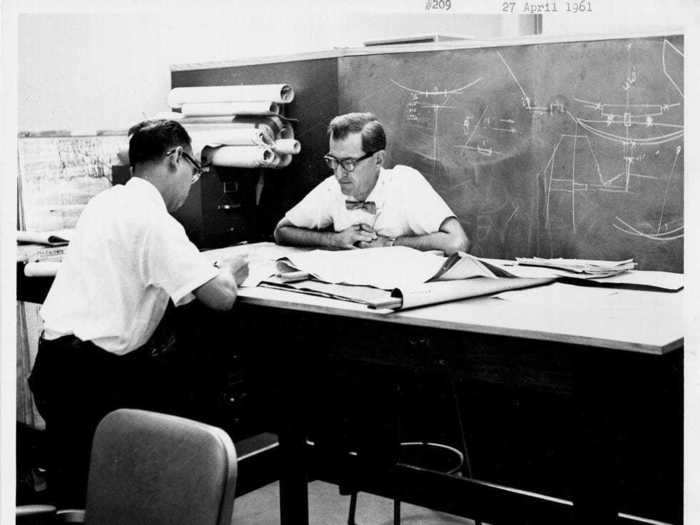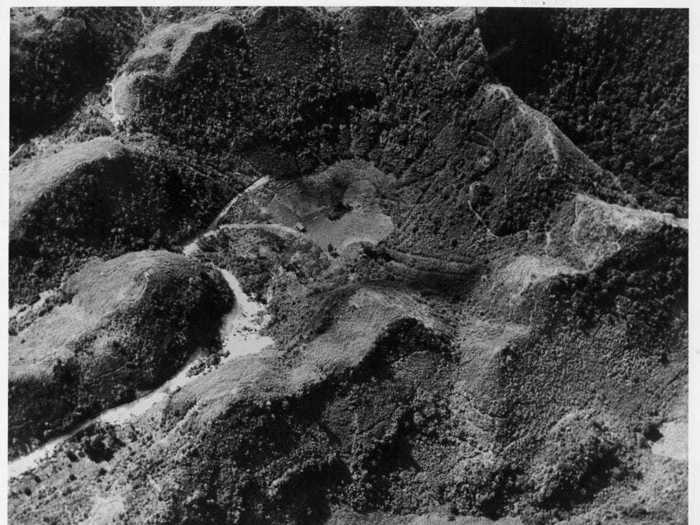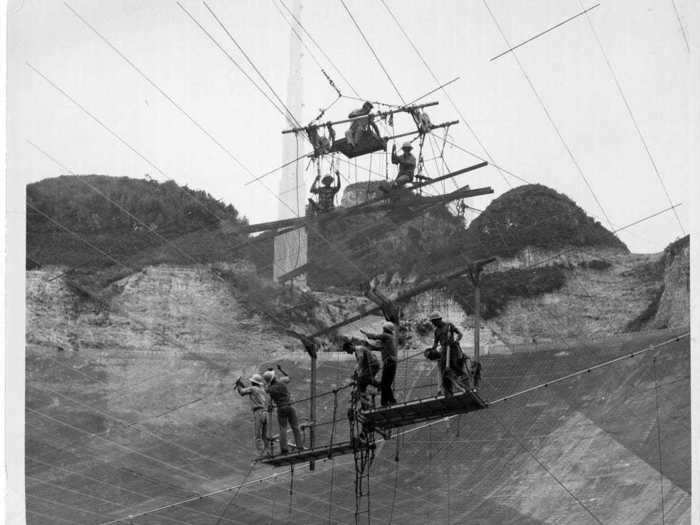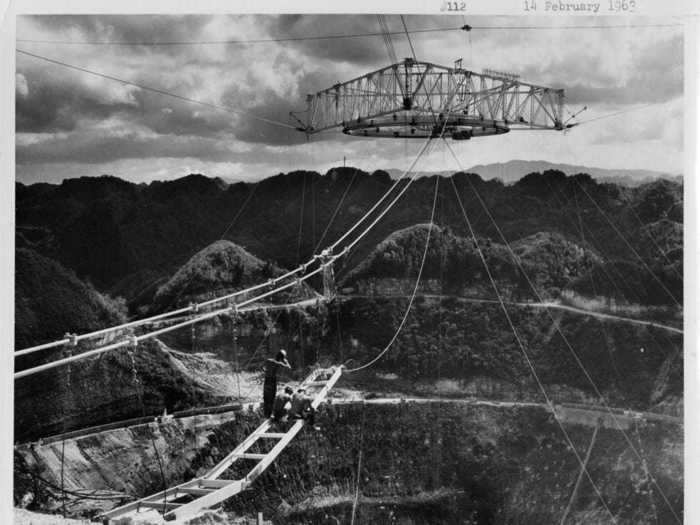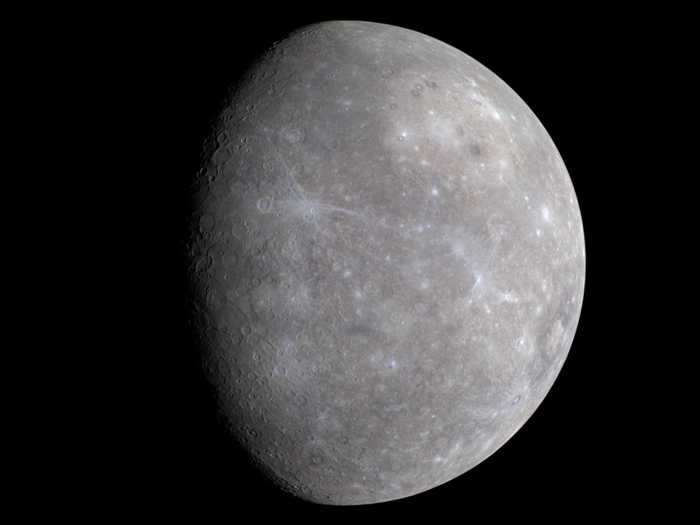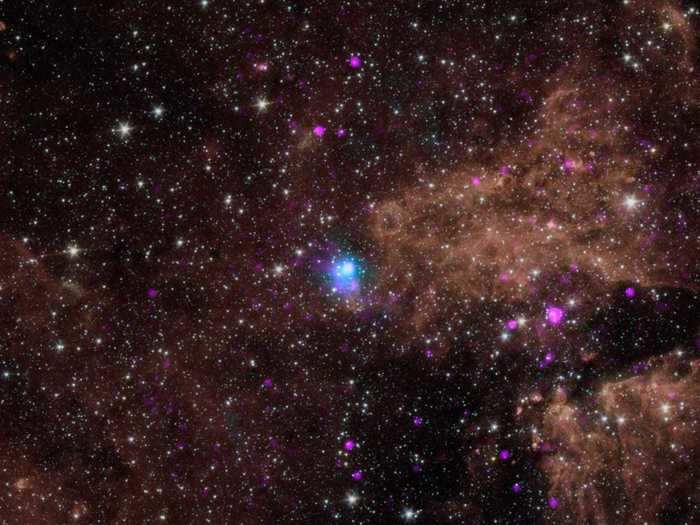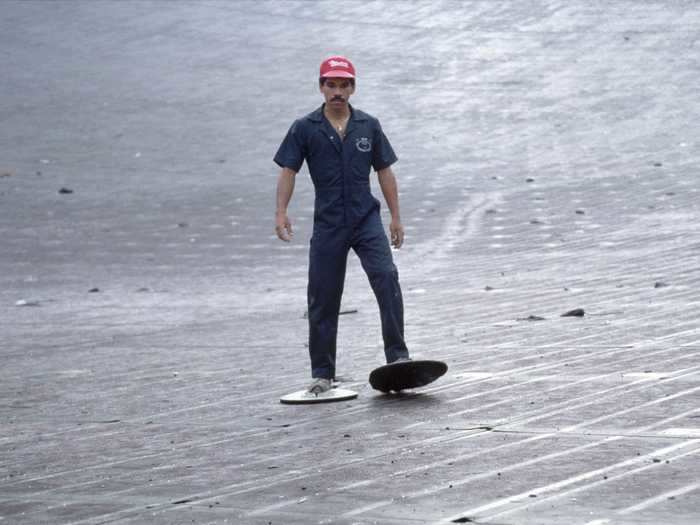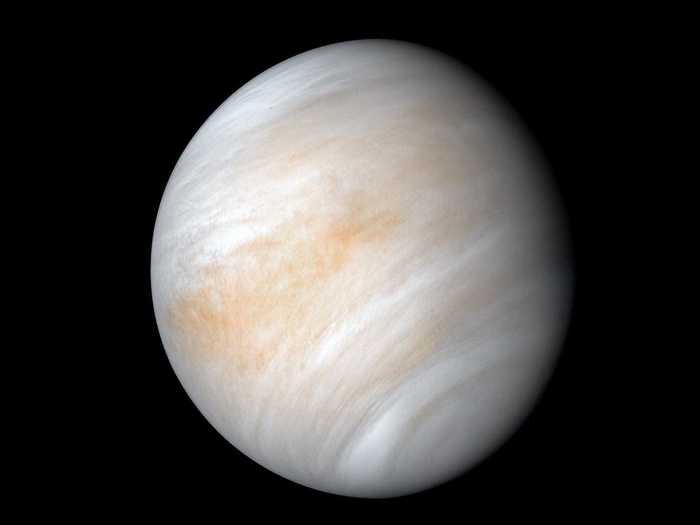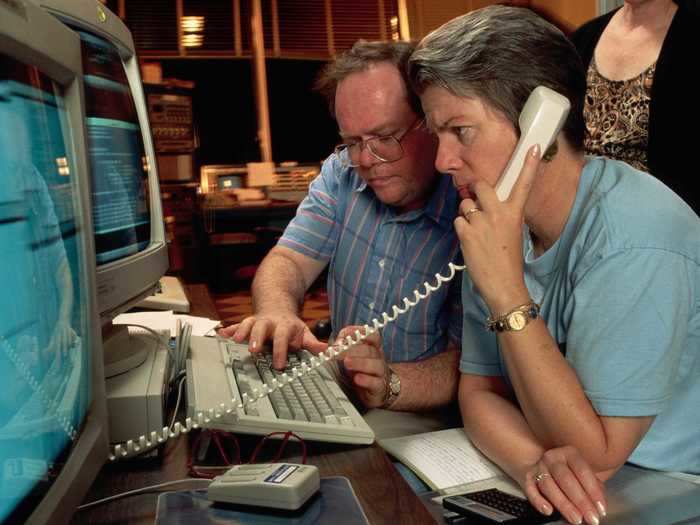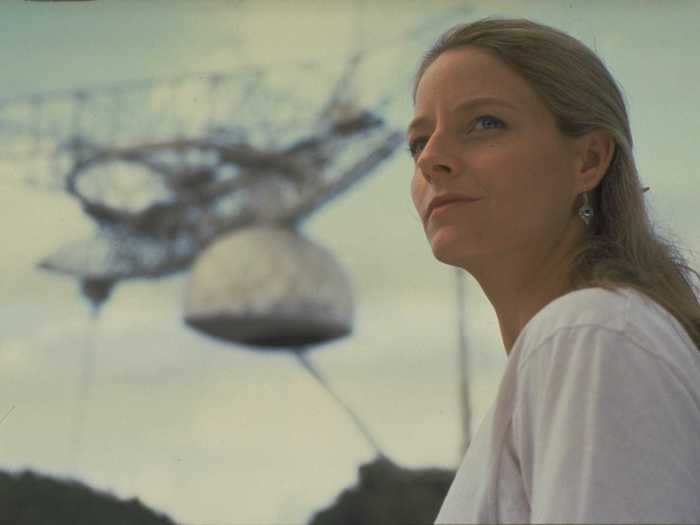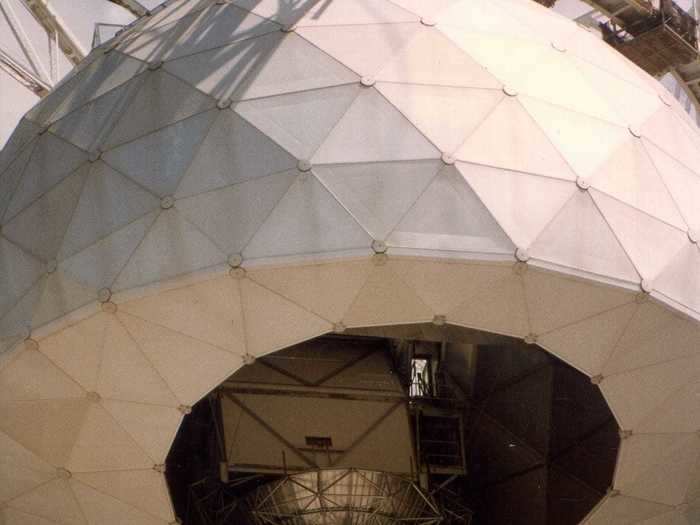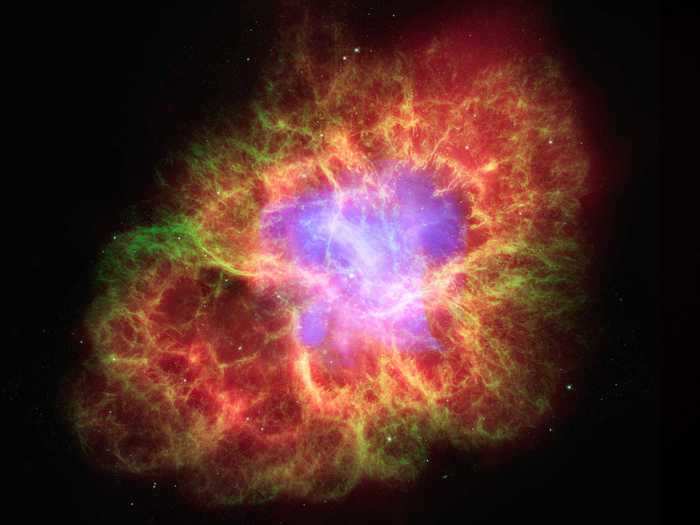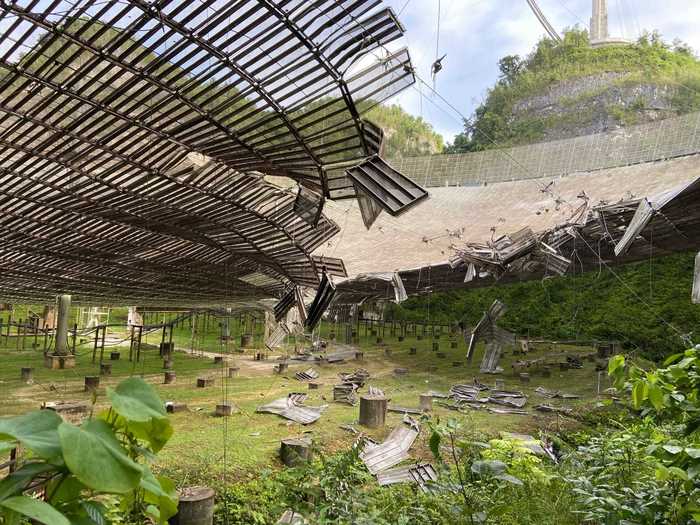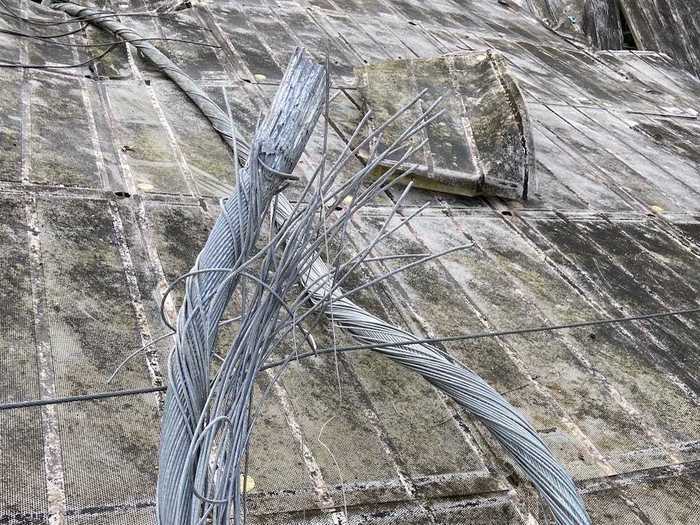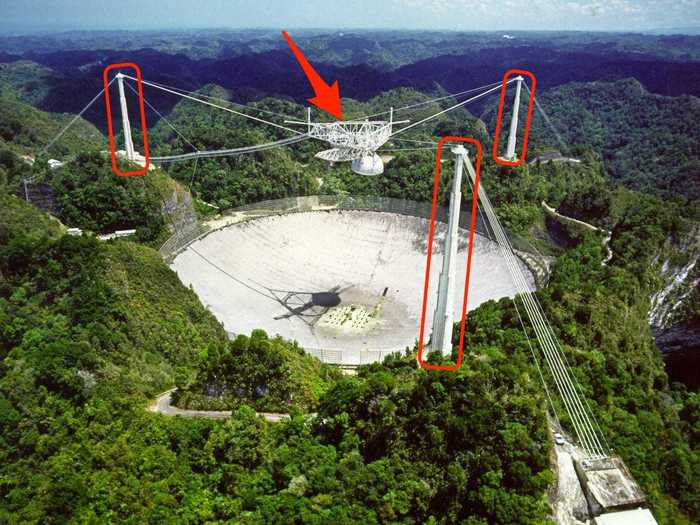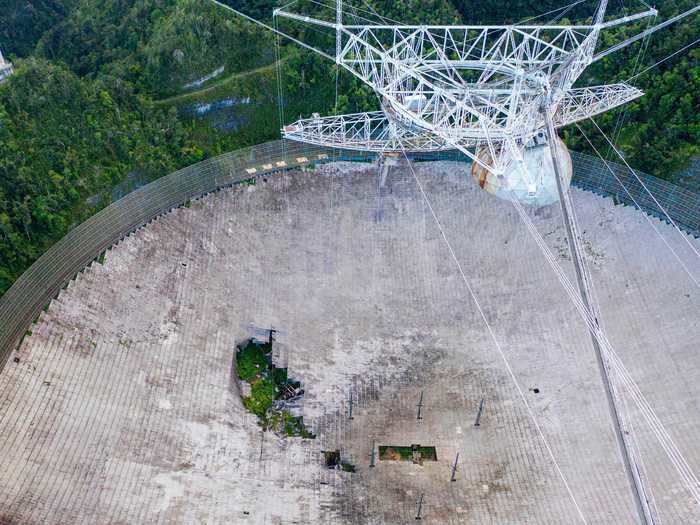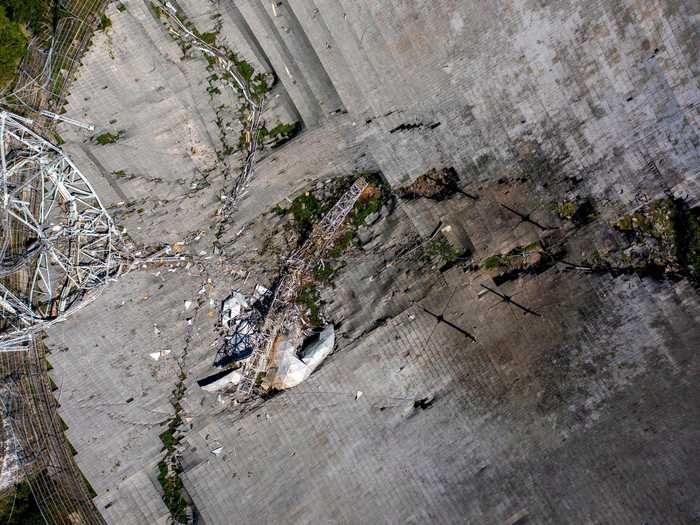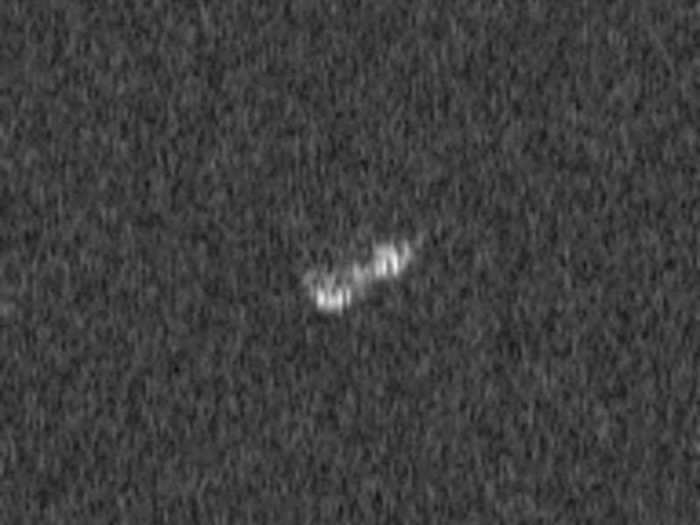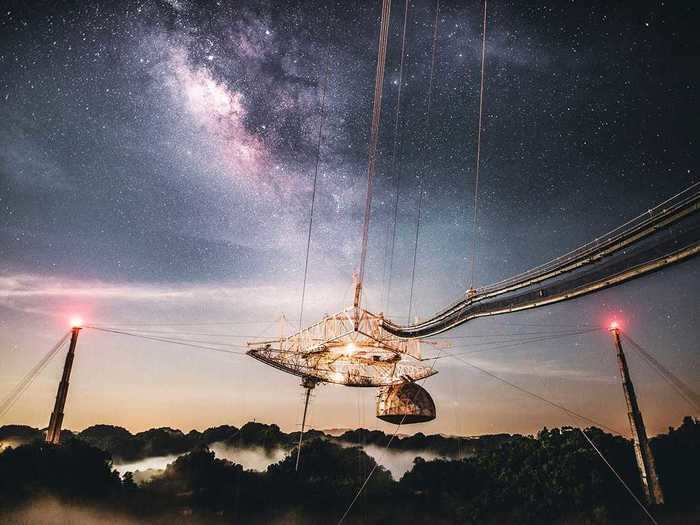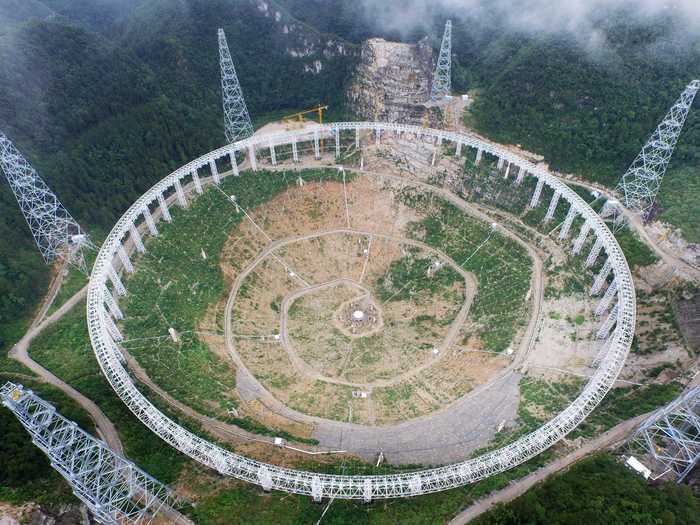The Arecibo Observatory in Puerto Rico as seen before its collapse.NAIC Arecibo Observatory/NSF
- The Arecibo Telescope collapsed on Tuesday: Its 900-ton hanging platform crashed into its main dish.
- The disaster ended 57 years of historic radio astronomy. Arecibo tracked potentially hazardous asteroids, discovered the first exoplanet, and broadcast a message for aliens.
- The telescope even starred in a James Bond film and the movie "Contact."
One of the world's largest and most iconic radio telescopes collapsed on Tuesday.
In its 57 years, the Arecibo Observatory in Puerto Rico revolutionized radio astronomy. It beamed messages to potential aliens, tracked asteroids that could crash into Earth, and discovered the first exoplanet.
It also weathered hurricanes and earthquakes for years. But after Tropical Storm Isaias passed over the island this summer, the cables holding the telescope's receiver platform above its reflector dish began to fail. Shortly after, the National Science Foundation, which owns the telescope, declared that it was too unstable to safely repair. The plan was to try to disassemble it, but then the 900-ton platform broke loose and crashed into the 1,000-foot disk below.
"When I learned of the news, I was totally devastated," Abel Mendez, the director of the Planetary Habitability Laboratory at the University of Puerto Rico at Arecibo, told Business Insider when the telescope was decommissioned last month.
Mendez had been around the observatory since he was 10 years old and worked with it professionally for the past decade.
"It's hard to take. It's like losing someone important in your life," he said. "Yeah, 2020 — it's not good."
Here's what Arecibo accomplished in its lifetime, and what the world has lost with its demise.
Cornell University professor William E. Gordon began designing the Arecibo Observatory in 1958.
William Gordon, who designed the Arecibo Observatory, makes plans with Domingo Albino, the first Puerto Rican engineer to work there, April 1961.
Arecibo Observatory
He wanted to use radar to study the ionosphere: a layer of electrons in Earth's upper atmosphere that interacts with particles in space to create the aurora.
He chose a natural sinkhole in Puerto Rico, where the terrain would fit the telescope's deep, 1,000-foot-wide dish.
The sinkhole where Arecibo was to be built, June 1960.
Arecibo Observatory
Building the observatory close to the equator would also make it easier to study nearby planets.
Construction began in the summer of 1960. Building the world's largest radio telescope was no easy feat.
Workers connect cables under the dish so its panels can be installed, July 1963.
Arecibo Observatory
"I do not know how we ever built it," Gordon later told a gathering at the observatory in 2003.
He added that the telescope was only designed to last 10 years, but said he hoped it would live another 40.
In 1963, the dish was completed with the reflection platform raised above it, supported by 18 cables connected to three towers.
Workers construct a catwalk to the telescope's platform, February 1963.
Arecibo Observatory
"A big cheer went up when it was completed," Gordon said.
After that Arecibo's massive dish antennae began to ping celestial objects by reflecting radio waves from space to its suspended platform.
The telescope started to observe the cosmos. Its first major discovery was that scientists had Mercury's rotation all wrong.
A mosaic portrait of Mercury, taken by the MESSENGER spacecraft on January 14, 2008.
NASA/Johns Hopkins University Applied Physics Laboratory/Carnegie
Astronomers previously thought that Mercury rotated every 88 days, but Arecibo found that it was actually every 59 days. The telescope also showed that the planet is not tidally locked with the sun, as astronomers previously believed.
Then in 1974 it detected the first ever binary pulsar: a highly magnetized, compact star orbiting another star. This was a confirmation of Einstein's theory of general relativity.
The blue dot in this image marks the spot of an energetic pulsar — the magnetic, spinning core of star that blew up in a supernova explosion.
NASA/JPL-Caltech/SAO
The physicists behind the discovery, Russell Hulse and Joseph Taylor, later won the Nobel Prize in Physics.
That same year, Arecibo beamed the most powerful broadcast Earth has ever sent to communicate with potential aliens.
Technician Luis Heredia uses flat shoes to walk on the 20-acre dish of the Arecibo Radio Telescope without damaging the instrument's precise shape.
Roger Ressmeyer/Corbis/VCG via Getty Images
The message contained information about the basic chemicals of life on Earth, the building blocks and shape of our DNA, the human figure, a map of our solar system, and a description of Arecibo itself.
Its radar made the first maps of Venus's surface in 1981.
An image of Venus and its thick clouds taken by NASA's Mariner 10 mission during a planetary flyby maneuver in February, 1974.
Kevin M. Gill/NASA/JPL-Caletech
Previously, optical observations of the planet could only show the thick haze of clouds in its atmosphere.
In 1992, Arecibo discovered the first known planet beyond our solar system.
Larry Webster and Jill Tarter watch computer screens at the Arecibo Observatory, working on the search for signs of extraterrestrial life, October 10, 1992.
Roger Ressmeyer/Corbis/VCG via Getty Images
Later observations revealed an entire planetary system orbiting a pulsar.
The telescope made appearances in the 1995 James Bond film "GoldenEye" and the 1997 film "Contact."
Jodi Foster in the film "Contact," based on a novel by Carl Sagan.
Francois Duhamel/Sygma via Getty Images
Arecibo was visually striking due to both its size and its jungle setting.
In 1997, the observatory got its Gregorian Dome.
The Gregorian Dome hangs from the receiver platform.
Arecibo Observatory
The technology focuses the telescope's radiation to the points in space that astronomers want to study.
Arecibo identified the world's first repeating fast radio burst — millisecond pulses of radio from beyond our galaxy.
A super-dense neutron star, the remains of a supernova explosion, as captured by three NASA observatories.
NASA/JPL-Caltech/ESA/CXC/Univ. of Ariz./Univ. of Szeged
Some astronomers thought these signals could come from alien technology. But more recent discoveries indicate that dead stars produce the bursts.
Arecibo's woes began in August, shortly after Tropical Storm Isaias passed over Puerto Rico. An auxiliary cable broke and crashed into the dish below.
A hole in the 1,000-foot-wide reflector dish of the Arecibo Observatory, torn when a cable fell on August 10, 2020.
Arecibo Observatory
It tore a 100-foot gash in the reflector dish.
Three months later, just before engineers were set to begin repairs, a 15,000-pound main cable broke from the same tower and crashed into the dish.
The auxiliary cable that broke on August 10, 2020 was 3 inches thick.
Arecibo Observatory
Astronomers began to worry seriously about the telescope's fate.
"Its sensitivity is so much greater than any other instrument and it's so much more flexible," Joanna Rankin, a radio astronomer at the University of Vermont, told Science after the second failure, adding that Arecibo can see "from the stratosphere to the far reaches of the universe."
"It would be a tremendous shame if that was lost," she said.
Then assessments engineers warned that if another cable were to break from the same tower, that could send the 900-ton platform plummeting into the dish below. It would bring all three towers with it.
The radio-antenna platform of the Arecibo Observatory in Puerto Rico, as well as three support towers.
NAIC Arecibo Observatory/NSF; Business Insider
The new break had shown that the remaining cables were no longer reliable. That meant a collapse could happen at anytime, which made it unsafe for engineers to attempt to stabilize or repair the telescope.
So the NSF decommissioned the telescope, and engineers set about figuring out how to deconstruct it safely.
An aerial view shows the hole in Arecibo's dish after a second cable failure on November 19, 2020.
Ricardo Arduengo/AFP/Getty Images
"This decision is not an easy one for NSF to make. But safety of people is our No. 1 priority," Sean Jones, the assistant director for the NSF's Mathematical and Physical Sciences directorate, said in a press conference on November 19.
Over the past two decades, the NSF has spent more than $200 million operating and maintaining the observatory.
If engineers could take apart the telescope before it collapsed, the foundation had a shot at preserving the visitor's center and nearby lidar facilities.
But before they could make an attempt at taking it apart, the platform collapsed. All 900 tons of it smashed into the disk below, tearing off the tops of the three towers.
The 900-ton platform crashed into the Arecibo telescope's main dish on December 1, 2020.
Ricardo Arduengo/AFP/Getty Images
It happened around 7:55 a.m. local time on Tuesday. All the cables fell as well.
"I feel sick in my stomach," Ramon Lugo, the director of the Florida Space Institute at the University of Central Florida, who managed the telescope, told Science. "Truthfully, it was a lot of hard work by a lot of people trying to restore this facility. It's disappointing we weren't successful. It's really a hard morning."
The loss of Arecibo is a major blow to the world's defenses against hazardous asteroids.
The peanut-shaped 2015 BN590 asteroid, which is shaped like a peanut, is a potentially hazardous object that might one day hit Earth.
Arecibo Observatory/NASA/NSF
Though Arecibo doesn't discover dangerous space rocks, it's instrumental in investigating them, Mendez said: The observatory can ping such objects with radar to decrypt their shape, rotation, surface features, and trajectory through space.
Arecibo was also the best shot the US had at a comprehensive project to search for radio waves from alien technology.
A starry sky above the observatory.
University of Central Florida
With its demise, that possibility dies, Mendez said.
Other NSF facilities, like the Green Bank Observatory in West Virginia, could take on some Arecibo science. But Mendez said Green Bank is only 10% to 20% as sensitive to weak radio signals as Arecibo was.
The only radio telescope on Earth that can hold a candle to Arecibo is China's Five-hundred-meter Aperture Spherical Radio Telescope (FAST).
The assembly site of China's FAST telescope on July 28, 2015 in Pingtang, China.
Feature China/Barcroft Media via Getty Images
"If you are monitoring a source of interest which is in the weak radio spectrum, you need two big radio telescopes: one pointing toward something during the day and the other through the nighttime," Mendez said. "If you lose Arecibo, then you lose the ability to monitor — 24 hours a day — a faint source of radio signals."
He added: "Now we just have one eye."
Already, astronomers are sharing ideas for building a state-of-the-art facility in Arecibo's place.
An aerial view shows the damage at the Arecibo Observatory after one of the main cables holding the receiver broke in Arecibo, Puerto Rico, on December 1, 2020.
Ricardo Arduengo/AFP/Getty Images
This would require the incoming Biden administration to push for such an effort and Congress to fund it.
"A rebuilt Arecibo would be an important scientific instrument in many realms, notably gravitational waves," Saavik Ford, an astrophysicist at the City University of New York and the American Museum of Natural History, wrote to an astronomy email list before the observatory's downfall.
She added: "Rebuilding is a choice which would yield both economic benefits and (importantly) scientific advances."
Dave Mosher and Aylin Woodward contributed reporting.

